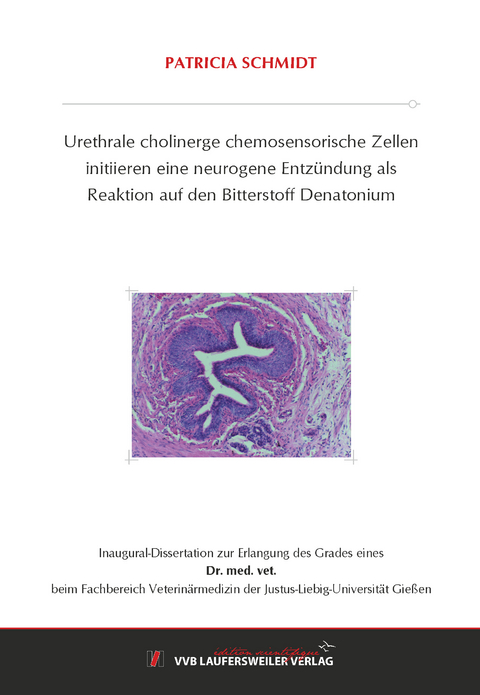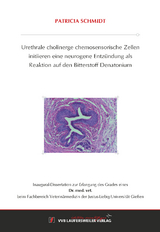Urethrale cholinerge chemosensorische Zellen initiieren eine neurogene Entzündung als Reaktion auf den Bitterstoff Denatonium
Seiten
2021
VVB Laufersweiler Verlag
978-3-8359-6995-7 (ISBN)
VVB Laufersweiler Verlag
978-3-8359-6995-7 (ISBN)
- Keine Verlagsinformationen verfügbar
- Artikel merken
Harnwegsinfekte gehören zu den häufigsten bakteriellen Infektionen weltweit und werden multifaktoriell in ihrer Entstehung beeinflusst. Zu den Harnwegsinfekten zählen Infektionen der Urethra (Urethritis), der Blase (Cystitis), des Ureters (Ureteritis) und der Nieren (Pyelonephritis). Angesichts der Häufigkeit der Erkrankung ist es von entscheidender Wichtigkeit, mehr über die Grundlagen der Bakterien-Wirts-Beziehung und die Mechanismen im Körper zu erfahren, die sich bei einer Harnwegsinfektion abspielen. Dieses Verständnis könnte später die Grundlage für neue alternative Therapien und Therapieansatzpunkte bilden.
UCCC sind cholinerge chemosensorische Zellen in der Urethra, die Geschmacksrezeptoren und Proteine der klassischen Geschmackstransduktionskaskade wie den Kationenkanal TRPM5 exprimieren. Sie fungieren als Wächter am Eingang des Urogenitaltraktes und initiieren in Gegenwart von potenziell schädlichen Substanzen oder Pathogenen reflektorische Blasenentleerung Schutzmechanismus.
Diese Arbeit untersuchte einen möglichen Zusammenhang zwischen der Aktivierung von UCCC durch den Bitterstoff Denatonium und der Entstehung einer neurogenen Entzündung als einen weiteren lokalen Abwehrmechanismus.
Mäusen, denen Evans Blue, ein Marker für Plasmaextravasation, intravenös injiziert wurde, wurde anschließend intraurethral der UCCC-aktivierende Bitterstoff Denatonium appliziert. Denatonium verursachte eine gesteigerte Plasmaextravasation in Urethrae von C57BL/6J-Mäusen, nicht jedoch in Urethrae von TRPM5-KO Mäusen. In TRPM5-KO Mäusen ist die in der Urethra ausschließlich in UCCC exprimierte Geschmackstransduktionskaskade defekt. Das Blockieren von nikotinischen Acetylcholinrezeptoren oder SP-Rezeptoren (Neurokinin-1-Rezeptoren) führte zu einer signifikanten Abnahme der denatonium-induzierten gesteigerten Plasmaextravasation. Immunhistochemische Untersuchungen zeigten eine enge räumliche Nähe von UCCC und CGRP- und SP-positiven Nervenfasern mit nikotinischen Rezeptoren. In der Untersuchung von Gewebeüberständen zeigte sich nach Denatoniumapplikation eine signifikante Freisetzung von SP und CGRP aus Urethrae von C57BL/6J-Mäusen. Aus Urethrae von TRPM5-KO-Mäusen wurde nach Denatoniumapplikation signifikant weniger SP und CGRP freigesetzt.
Diese Ergebnisse zeigen, dass UCCC als Reaktion auf einen bitteren Reiz eine neurogene Entzündung initiieren. Durch UCCC-Aktivierung freigesetztes Acetylcholin bewirkt über nikotinische Acetylcholinrezeptoren eine SP-Freisetzung aus sensorischen Nervenendigungen. Das freigesetzte SP verursacht an der Reizstelle ein Ödem, ein Kennzeichen der neurogenen Entzündung. Urinary tract infections are among the most common bacterial infections worldwide and their development depends on multiple factors. Urinary tract infections include infections of the urethra (urethritis), bladder (cystitis), ureter (ureteritis) and kidney (pyelonephritis). Given the prevalence of this disease, it is of vital importance to understand the principles of the host-pathogen interaction and the mechanisms taking place in the body during urinary tract infections. Understanding these complex processes could build the fundament for new alternative therapies and therapeutic approaches.
UCCC are cholinergic chemosensory cells in the urethra that express taste receptors and proteins of the canonical taste transduction cascade such as the cation channel TRPM5. They act as sentinels at the entrance to the urogenital tract and initiate reflexive protective mechanisms such as voiding of the bladder in the presence of potentially harmful substances or pathogens.
This study investigated a possible link between UCCC-activation by bitter substance denatonium and the development of neurogenic inflammation as an additional local defense mechanism.
Mice were injected intravenously with Evans Blue, a marker for plasma extravasation. Subsequently, the UCCC-activating bitter substance denatonium was administered into the urethra. Denatonium caused increased plasma extravasation in the urethra of C57BL/6J mice, but not in the urethra of TRPM5-KO mice. In TRPM5-KO mice, the taste transduction cascade expressed exclusively in UCCC in the urethra is defective. The blocking of nicotinic acetylcholine receptors or SP receptors (neurokinin-1 receptors) led to a significant decrease in denatonium-induced increased plasma extravasation. Immunohistochemical investigations showed close proximity of UCCC and CGRP- and SP-positive nerve fibers with nicotinic receptors. The examination of tissue supernatants showed a significant release of SP and CGRP from the urethra of C57BL/6J mice after application of denatonium. In contrast, significantly less SP and CGRP were released from the urethra of TRPM5-KO mice after application of denatonium.
These results show that in response to bitter stimuli, UCCC initiate a neurogenic inflammation. Acetylcholine released through UCCC-activation causes by means of nicotinic acetylcholine receptors the release of SP from sensory nerve endings. Released SP leads to edema, a hallmark of neurogenic inflammation.
UCCC sind cholinerge chemosensorische Zellen in der Urethra, die Geschmacksrezeptoren und Proteine der klassischen Geschmackstransduktionskaskade wie den Kationenkanal TRPM5 exprimieren. Sie fungieren als Wächter am Eingang des Urogenitaltraktes und initiieren in Gegenwart von potenziell schädlichen Substanzen oder Pathogenen reflektorische Blasenentleerung Schutzmechanismus.
Diese Arbeit untersuchte einen möglichen Zusammenhang zwischen der Aktivierung von UCCC durch den Bitterstoff Denatonium und der Entstehung einer neurogenen Entzündung als einen weiteren lokalen Abwehrmechanismus.
Mäusen, denen Evans Blue, ein Marker für Plasmaextravasation, intravenös injiziert wurde, wurde anschließend intraurethral der UCCC-aktivierende Bitterstoff Denatonium appliziert. Denatonium verursachte eine gesteigerte Plasmaextravasation in Urethrae von C57BL/6J-Mäusen, nicht jedoch in Urethrae von TRPM5-KO Mäusen. In TRPM5-KO Mäusen ist die in der Urethra ausschließlich in UCCC exprimierte Geschmackstransduktionskaskade defekt. Das Blockieren von nikotinischen Acetylcholinrezeptoren oder SP-Rezeptoren (Neurokinin-1-Rezeptoren) führte zu einer signifikanten Abnahme der denatonium-induzierten gesteigerten Plasmaextravasation. Immunhistochemische Untersuchungen zeigten eine enge räumliche Nähe von UCCC und CGRP- und SP-positiven Nervenfasern mit nikotinischen Rezeptoren. In der Untersuchung von Gewebeüberständen zeigte sich nach Denatoniumapplikation eine signifikante Freisetzung von SP und CGRP aus Urethrae von C57BL/6J-Mäusen. Aus Urethrae von TRPM5-KO-Mäusen wurde nach Denatoniumapplikation signifikant weniger SP und CGRP freigesetzt.
Diese Ergebnisse zeigen, dass UCCC als Reaktion auf einen bitteren Reiz eine neurogene Entzündung initiieren. Durch UCCC-Aktivierung freigesetztes Acetylcholin bewirkt über nikotinische Acetylcholinrezeptoren eine SP-Freisetzung aus sensorischen Nervenendigungen. Das freigesetzte SP verursacht an der Reizstelle ein Ödem, ein Kennzeichen der neurogenen Entzündung. Urinary tract infections are among the most common bacterial infections worldwide and their development depends on multiple factors. Urinary tract infections include infections of the urethra (urethritis), bladder (cystitis), ureter (ureteritis) and kidney (pyelonephritis). Given the prevalence of this disease, it is of vital importance to understand the principles of the host-pathogen interaction and the mechanisms taking place in the body during urinary tract infections. Understanding these complex processes could build the fundament for new alternative therapies and therapeutic approaches.
UCCC are cholinergic chemosensory cells in the urethra that express taste receptors and proteins of the canonical taste transduction cascade such as the cation channel TRPM5. They act as sentinels at the entrance to the urogenital tract and initiate reflexive protective mechanisms such as voiding of the bladder in the presence of potentially harmful substances or pathogens.
This study investigated a possible link between UCCC-activation by bitter substance denatonium and the development of neurogenic inflammation as an additional local defense mechanism.
Mice were injected intravenously with Evans Blue, a marker for plasma extravasation. Subsequently, the UCCC-activating bitter substance denatonium was administered into the urethra. Denatonium caused increased plasma extravasation in the urethra of C57BL/6J mice, but not in the urethra of TRPM5-KO mice. In TRPM5-KO mice, the taste transduction cascade expressed exclusively in UCCC in the urethra is defective. The blocking of nicotinic acetylcholine receptors or SP receptors (neurokinin-1 receptors) led to a significant decrease in denatonium-induced increased plasma extravasation. Immunohistochemical investigations showed close proximity of UCCC and CGRP- and SP-positive nerve fibers with nicotinic receptors. The examination of tissue supernatants showed a significant release of SP and CGRP from the urethra of C57BL/6J mice after application of denatonium. In contrast, significantly less SP and CGRP were released from the urethra of TRPM5-KO mice after application of denatonium.
These results show that in response to bitter stimuli, UCCC initiate a neurogenic inflammation. Acetylcholine released through UCCC-activation causes by means of nicotinic acetylcholine receptors the release of SP from sensory nerve endings. Released SP leads to edema, a hallmark of neurogenic inflammation.
| Erscheinungsdatum | 10.01.2022 |
|---|---|
| Reihe/Serie | Edition Scientifique |
| Verlagsort | Gießen |
| Sprache | deutsch |
| Maße | 148 x 210 mm |
| Gewicht | 200 g |
| Themenwelt | Veterinärmedizin ► Allgemein |
| Schlagworte | Bitterstoff • Bürstenzelle • Entzündung • Harnwegsinfekt • UCCC |
| ISBN-10 | 3-8359-6995-1 / 3835969951 |
| ISBN-13 | 978-3-8359-6995-7 / 9783835969957 |
| Zustand | Neuware |
| Informationen gemäß Produktsicherheitsverordnung (GPSR) | |
| Haben Sie eine Frage zum Produkt? |

